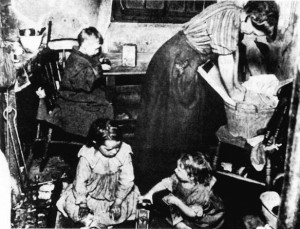 The Western world first industrialized in Great Britain, prompting vast numbers of inhabitants to move from the agricultural countryside to urban centers. Living and working conditions were deplorable. Andrew Mearn wrote in 1883 of the “pestilential human rookeries … where tens of thousands are crowded.” He continues:
The Western world first industrialized in Great Britain, prompting vast numbers of inhabitants to move from the agricultural countryside to urban centers. Living and working conditions were deplorable. Andrew Mearn wrote in 1883 of the “pestilential human rookeries … where tens of thousands are crowded.” He continues:
To get to them you have to penetrate courts reeking with poisonous and malodorous gases arising from accumulations of sewage and refuse scattered in all directions and often flowing beneath your feet; courts, many of them which the sun never penetrates, which are never visited by a breath of fresh air, and which rarely know the virtues of a drop of cleansing water…. You have to grope your way along dark and filthy passages swarming with vermin. Then, if you are not driven back by the intolerable stench, you may gain admittance to the dens in which these thousands of beings who belong, as much as you, to the race for whom Christ died, herd together.
Pretty graphic. Roy Porter’s comment on this passage: “Historians still dispute whether industrialization raised or depressed wages and living standards – something, perhaps, impossible to measure.”
London then and now
I’ve been reading about the London riots and thinking about what’s different today, both for the socially disadvantaged – the poor, the unemployed, the uneducated and undereducated, immigrants, ethnic minorities, the children of all of the above – and for the governments responsible for maintaining social order. One difference is that we have, to a large extent, eliminated the enormous threat of infectious diseases that thrived in unsanitary living conditions. What hasn’t changed is the reluctance of those in power to take responsibility for the living conditions – both physical and mental – of the socially disadvantaged.
Here’s Roy Porter again, discussing the government’s attitude towards the health of the working class poor in the 19th century (emphasis added):
Awash with people and haunted by premature death, the nineteenth-century shock towns had their evils unceasingly spotlighted. But it would be naive to assume that once the evils of industrial society were exposed they were automatically righted. Together with the question of medical efficacy, imponderable issues were raised of culpability, individual rights, the duties of government and the sanctity of private property. Could such evils be rectified? Or were they nobody’s fault, nobody’s business, all a muddle, best left to individual action or the hidden hand? And if they could be remedied, how and by whom? And who would foot the bill? These issues were real, even if they often served as sanctimonious excuses for inertia by those who worshipped Mammon. …
Especially in the Anglo-American world, political economy ordained freedom of trade; it was not for Parliament or Congress lightly to meddle with people’s livelihoods. Government would uphold the law, and it was up to individuals to be healthy and to charity [or today’s volunteers?] to rectify hardships. Whether to work in a deadly trade was a free and individual decision. When operatives fell sick, blame was often laid upon their faulty constitutions, regarded as the root cause of work-triggered consumption or blindness.
Nevertheless, despite the ideological attractiveness of self-help doctrines, no state could idly stand by and watch the crippling impact of mass diseases — anyone might die, Prince Consorts and all, and the social fabric was under strain with revolution in the air. Surrounded by the great unwashed and threatened by cholera, jittery members of society feared that disease might spark insurrection — or might spread to them. They began to look to urban cleansing and health reform as medicine for society, even as an opium of the people. Cleanliness was next to godliness. With disease spelling disorder and danger, public responses followed.
In the 19th century, the working classes were much needed to maintain the engine of industrial production. It was the first century in which the population was able to replace itself through reproduction. But just barely. Not only did children die of infectious diseases. So did many of their mothers shortly after they gave birth.
In today’s global economy, the socially disadvantaged are no longer needed to supply the labor market. Nor are they needed in the militia, which was once a concern that motivated governments to care about the physical health of the poor. Without infectious diseases, without the need for workers or soldiers, the financial interests that determine what happens in the world no longer have to care about the consequences of wealth inequality. We see this playing out between the Greeks and their prosperous neighbors in the current European economic crisis.
Will the London riots raise questions about a social and economic system that doesn’t care about the socially disadvantaged? Questions, certainly. Will that be enough to change public attitudes and government policies? Probably not. Unfortunately, the situation will need to get much worse. And even when that happens, current financial interests are likely to prevail.
Is this discouraging? Yes, but …. This struggle has a long history of gradual progress. When the British Public Health Act of 1848 proposed improving sanitation for the poor, editorials argued “Cholera is the best of all sanitary reformers.” Surely we have more sense — and compassion — than that now. Plus, in common with many who came before us, we have a firm conviction that this is a struggle worth waging and worth winning.
Related posts:
Health inequities: An inhumane history
Déjà vu: Historical resistance to the inequities of health
Health inequities, politics, and the public option
Health care inequality: The US vs. Europe


Sorry, comments are closed for this post.